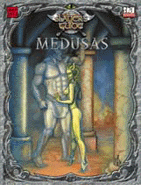
|
About OgreCave and its staff
|

|
by Orion Holcomb
The Slayer's Guide to Medusas, like the other volumes in the series, is a d20 supplement intended to add background and flesh out the information found in the Monster Manual. Unlike the other Slayers Guides, the topic of medusas doesn't immediately make its potential known, as most gamers have only ever seen them portrayed in . Players and GMs alike may be caught off guard by the unique twists the book applies, turning a classic-but-obvious creature once again into a force to be reckoned with.
Know Your Snake Women The Guide's introduction reminds us that medusas can easily become an obvious and worn out enemy, but that there are many more possibilities for members of this race. The physiology section details their origin, dietary requirements, life cycle and reproduction. The section on medusa society goes into detail on how members of this race interact with other medusas, and with other races. It also goes into their mindset, their view of the world, and their religion such as it is (they don't tend to be very religious). The section on habitat reminds us that medusa are as versatile as humans, can live anywhere and fit into any niche, and they prefer several lairs, where their considerable treasure can be stored. These sections provide a necessary background to a race few GMs make use of, and give several other interesting variations on the "Perseus vs Medusa in the ruins" scenario. Some details are left vague, as they are based on facts gathered by "'scholars' who have not so much seen a medusa, let alone studied one." Makes for more interesting reading, but I would rather have concrete facts in a book like this. Some of the medusa society section seems wordy and repetitive, but still contains useful information. The section on medusa combat reminds us how intelligent and cunning they can be. For example, medusas are intelligent enough to use sledgehammers to eliminate evidence of folks turned to stone. They prefer to be the aggressors in combat, to ensure things go according to plan, and attempt to flee if conditions are not favorable. The section on role-playing introduces two prestige classes for medusas: the guiser, who specializes in blending in with humans, and the serpentine, who have a close affinity to reptiles. Special medusa feats are also introduced here, including a few that make it difficult to avoid her gaze. These sections give medusas a much wider variety and should make our heroes far less certain that a hand mirror will save them. The two pages of scenario hooks and ideas provide GMs with inspiration, and while some ideas are obvious, there is enough variety to spark the imagination. The section detailing a medusa lair, "Sfiney's Gang," offers details on the primary lair of a covey of three medusas who are involved in a major city's underground. The maps are good illustrations, but they have no scale or compass. The three medusas have such a well-planned defense that they are likely to escape, after destroying their treasure. Their three other lairs are not detailed at all, which makes it difficult to run as a complete adventure. It also seems like just uncovering the truth (or a lead at least) about these three art thieving sisters would take substantial adventuring effort. This sounds like something to build a campaign around, in the shady subsurface of a city of your choice.
Conclusions As a whole, I strongly recommend the Slayer's Guide to Medusas. This supplement takes a misused or seldom used race, and makes them far more useful, flexible, and interesting as foes. The sample lair may not see action, but still provides ideas for a GM. Despite the danger, medusas are worth a second look.
|
||
 The Slayer's Guide to Medusas
The Slayer's Guide to Medusas